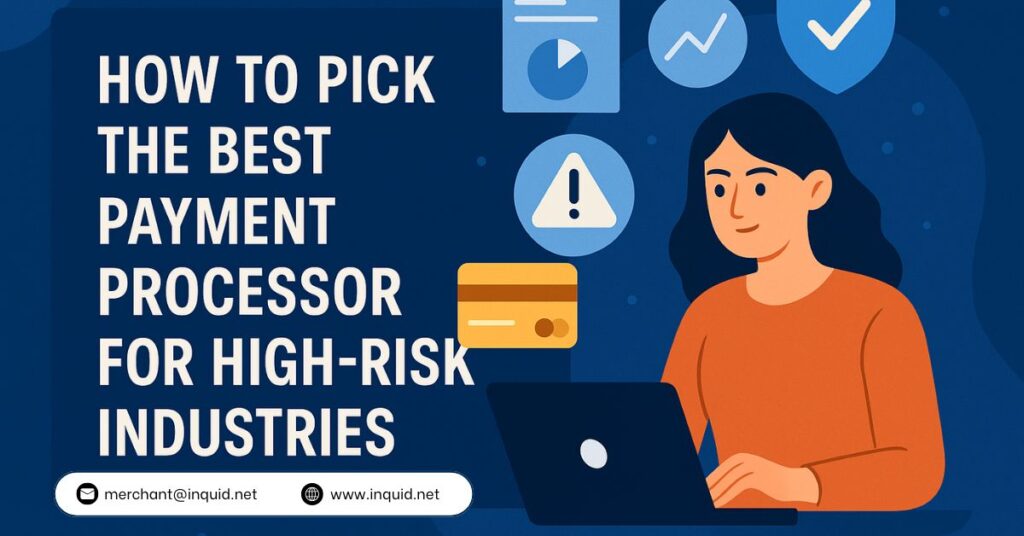
Finding a payment processor is already a challenge for most businesses. But for those labeled high-risk, the hurdles get tougher. From chargeback ratios to compliance demands, high-risk merchants face strict scrutiny. That’s why choosing the right payment processor isn’t just about pricing or speed—it’s about long-term compatibility with your business needs.
This guide walks through what high-risk businesses should look for in a payment processor, what red flags to avoid, and how to narrow down the best options in a crowded market.
What Makes a Business High-Risk?
Before diving into processor features, it’s important to understand why certain industries carry the high-risk label. Common reasons include:
- High chargeback rates
- Subscription-based billing
- International transactions
- Regulatory concerns
- Age-restricted content or services
Industries like online gaming, adult entertainment, forex trading, and gambling typically fall into this category. These types of businesses are often rejected by mainstream processors, pushing them to look for companies that specialize in high-risk payment processing.
Why the Right Processor Matters
Getting the wrong processor can lead to delayed settlements, frozen funds, or even sudden account termination. A processor that understands high-risk models will offer:
- Experience with compliance handling
- Multi-currency support
- Faster onboarding with clearer documentation
- High approval ratios for flagged industries
- Chargeback management tools
A mismatch, on the other hand, can bring technical headaches, regulatory issues, or even lost customers.
Key Factors to Look For
1. Industry Familiarity
Look for a provider with proven experience in your niche. If you’re in online gaming, for example, a general-purpose processor may not have the tools or integrations needed. Companies offering payment processing for gaming startups are better positioned to handle industry-specific needs like tokenization or recurring billing.
2. Risk Management Tools
High-risk businesses are often under greater scrutiny from card networks. So, you’ll need a processor that offers strong tools for fraud detection, chargeback prevention, and compliance monitoring. These features reduce the chance of account shutdown or rolling reserves.
3. Flexible Settlement Terms
Standard processors may delay payouts for weeks or longer. In contrast, high-risk processors may offer daily or weekly settlements with better reserve structures. Always check the fine print—some offer low fees upfront but tie you down with high rolling reserve percentages.
4. Support for Multiple Payment Methods
Your customers might prefer card payments, but having options matters. Look for processors that also support e-wallets, local bank transfers, or cryptocurrencies. This flexibility becomes critical for businesses serving international audiences or operating in regulated sectors.
5. Global Coverage
If your business has customers overseas, the processor must handle global payment flows. Cross-border capabilities, multi-currency processing, and local acquirers help reduce transaction failures and chargebacks. Choosing a processor with global reach is vital for long-term growth and stability.
Red Flags to Avoid
Not all processors claiming to support high-risk merchants actually deliver. Watch out for:
- No transparent fee breakdown
- Lack of real-time support
- No integration with standard payment gateway solutions
- Unclear reserve policies
- Overpromising on instant approvals
A strong processor will be upfront about documentation, timelines, and any reserve conditions.
Where to Start
If you’re starting from scratch, a good first step is understanding how payment processor companies work. Knowing the difference between aggregators, direct acquirers, and ISO partnerships can help you decide the best path forward.
inquid: A Partner for High-Risk Merchants
Navigating high-risk payment processing doesn’t have to feel like guesswork. At inquid, we specialize in helping high-risk businesses get approved faster with support that lasts beyond setup. We work with gaming, adult, forex, and other flagged industries, offering access to global processors, fraud tools, and personalized guidance.
Final Thoughts
Picking a payment processor for a high-risk business isn’t about speed—it’s about compatibility and staying operational under pressure. Take time to review fee structures, supported industries, fraud tools, and settlement timelines before locking in a provider. Don’t just go with the one that claims to approve everyone. Go with the one that understands why your industry needs more than just a plug-and-play solution.
FAQs
What fees should high-risk businesses expect?
Most high-risk processors charge higher rates than traditional providers—typically between 4% to 7% per transaction—along with setup or monthly maintenance fees.
Are rolling reserves mandatory?
In many cases, yes. Rolling reserves are used to protect the processor from chargebacks or fraud. They vary by industry, but 5% to 10% is common.
Can I get approved if I have bad credit?
It depends on the processor. Some high-risk providers can work with poor credit, especially if your business model is solid and you have low chargeback ratios.
How long does approval usually take?
For high-risk merchants, approval can take anywhere from a few days to two weeks, depending on the documentation and risk level.
